Modeling and Averaging in Meteorology of Heterogeneous Domains - Follow-up the NATO PST.ASI.980064
Remarks on Some Reports Presented at this NATO AS-980064 Institute - Kiev, May 4-15, 2004
In these notes I would mostly comment on the studies, reports those have dealt
with the problems those can be quilified as the Two-Scale Problems. That was
an Official Topic of this ASI.
There were sufficient number of reports on problems definitely demanding the scaled formulation and solution.
Mostly, by the great number, those were the talks on meteorology,
environmental engineering, and air pollution subjects.
There were also just few talks when problems were formulated as for the industry related technical issues.
There were the results presented as the detailed DMM-DNM with the simulated fields often given as the 2D-3D distributions with interesting and valuable details.
Unfortunately, these are the utmost highest level of generalization. Authors cannot do analysis of their results, but to say - here we have this kind of field's data and there we probably have a vortex or more...
This is not an accident - authors of one scale solutions for the two-three scale problems do not possess the tools, methods to summarize their findings.
I am afraid that by these Remarks I could touch some nerves.
Still, there is no other choice I would have as to point out to researchers on
those inappropriate or even incorrect developments I had been having a
misfortune to be a witness. I apologize for the inconvenience this can bring.
Still, after all and first of all - this is my field also.
These studies have treated problems being:
1) As a one scale "lower" homogeneous statement problems with
some elements of reaching the second the Upper scale "averaged" models;
2) While another group had formulated their problems as on
the Upper "averaged " scale and tried to study some features of these
simulating or experimental models.
Only the one work-study (apart of my report) had the intention and formulation (incorrect anyway)
to study the physical problems on both scales - that was the report by
Pokrajac, D., Cambell, L., Manes, C., and McEwan, I.,
"Interpretation of PIV Measurements of Open Channel Flow over Rough Bed Using
Double-Averaged Navier-Stokes Equations," in NATO Advanced Study Institute-980064, Institute of
Hydromechanics, Kiev, pp. 156-157, 2004.
The governing equations for the Upper Scale in the abstract are shown as:

 here the averaging
here the averaging

 should mean the averaging over the fluid volume only, which in VAT is
should mean the averaging over the fluid volume only, which in VAT is

 and
and

 is the fluctuation in the fluid phase (not known how it is exactly relates to
other variables).
is the fluctuation in the fluid phase (not known how it is exactly relates to
other variables).
While at the conference report were presented other averaged equations, with some integral terms.
Recently the presentation's file of this report became available to me and I had a chance to observe
with a scrutiny the averaged governing equations authors shown at their conference lecture. Actually, the one equation.
The volume averaged turbulent (Reynolds averaged) equation of momentum. In the latter version of this averaged equation
there were produced almost every term for the fluid phase averaged form, but the turbulent friction resistance term.
Below I will return to this report in the "experimental" subsection of this website -
Group 1 Includes the Reports:
Amorim, J.H., Miranda, A.I., and Borrego, C., " Air
Pollutants Dispersion Disturbance Due to Urban Vegetation: a Porous Media
Modeling Approach to Lisbon City Centre," in NATO Advanced Study Institute-980064, Institute of
Hydromechanics, Kiev, pp. 46-47, 2004.
Here we see the convincing case of influence of trees (treated as a porous
medium) on the concentration levels of pollutant in the city's URL
environment.
There are obvious inhomogeneous pollutant's distributions in the streets of
Lisbon. The strong inhomogeneity of spatial distribution on the adsorbing
surfaces of the buildings testifies in favor of interfacial concentration
transport on the Upper scale of modeling spaces.
The modeling experiments
brought some features untreatable in the One scale Urban Modeling - those I would
like to discuss in the below subsection related to the Experimental efforts
demonstrated.
~~~
Baklanov, A.A., "Modelling of Urban Air Flows with Application to Air Pollution, Emergency Preparedness and Weather Prediction,"
in NATO Advanced Study Institute-980064, Institute of Hydromechanics, Kiev, pp. 15-19, 2004.
On page 15 we read - "The main objectives of the current European FUMAPEX project: "Integrated Systems for Forecasting Urban Meteorology, Air Pollution and Population Exposure" (web-site: http://fumapex.dmi.dk) are to improve meteorological forecasts for urban areas, the connection of numerical weather prediction models to urban air pollution and exposure models, build improved Urban Air Quality Information and Forecasting Systems, and demonstrate their application in cities subject to various European climates."
Page 16 - "Accordingly, considering the mentioned above features, the following aspects of the urban effects in the improved urban-scale NWP models should realized:.....
Calculation of effective
urban roughness
;"
Page 17 - "1. Simple corrections of the surface
roughness
for urban areas, e.g., following Mestayer et al., (2003), and heat fluxes (adding the albedo changes and additional urban heat flux, e.g. via heat producion in the city) within the existing non-urban physical parameterizations of the surface layer in the model with higher resolution and improved land-use classification. It is realized in the DMI-HIRLAM model. ........
Increased resolution and surface data-bases for the
roughness length
calculation in operational NWP models are considered and tested in DMI-HIRLAM, LM, MM5, and RAMS models, used by the FUMAPEX partners."
On page 18 we can read that -
"
Modified parameterizations and algorithms for
roughness parameters
in urban areas based on the morphologic methods are developed. ??....
Improved models for
urban roughness
sublayer simulation, including
(i) Effective
roughness
and flux aggregation technique,
(ii) Effect of stratification on the surface resistance over very rough surfaces,
(iii)
Roughness
for momentum, heat, and moisture, are suggested."
No questions, but ?
What a waste, What a cost of this "Roughness Science" ?
For more than 60 years since the time of Nikuradze and Schlichting the "science" of the roughness oust height,
the displacement height (d0) is just only the second after the Turbulence Theory in terms of time wasted and money spent for it.
And when for the first 40 years that was somehow justified, then nowadays ?
The progress now is that few groups in Australia, USA, France and the UK seems have stopped to use this language as the only possible one.
~~~
Hunt, J.C.R., "Discrete and Continuum Models of Flow and
Dispersion Through Canopies," in NATO Advanced Study
Institute-980064, Institute of Hydromechanics, Kiev, pp. 30-32, 2004.
Page 30: "2) spatially averaged properties determined by average drag forces
on the obstacles and their volume to displacements." The averaging assumed as
in a one huge volume to include everything in it.
Page 31 we read that - "The effect of the canopy on the mean flow can be
modeled as a distributed drag force (which depends on the wind speed in the
canopy and therefore has to be determined interactively)."
These two sentences above show that author does not know that these tools have
been already developed for 15-20 something years before. And that these
wishful ideas have been already studied and published.
The references are on the paper of 2003 - by Belcher, S.E., Jerram, N., and Hunt,
J.C.R., "Turbulence Structure Around a Columnar Vortex; Rapid Distortion
Theory and Vortex Wave Excitation," Journal of Fluid
Mechanics, Vol. Vol. 448, pp. 369-398, 2003.
and few more including:
Hunt, J.C.R. and Eames, I., "The Disappearance of Laminar and Turbulent Wakes
in Complex Flows," Journal of Fluid Mechanics, Vol. 457 ??, pp. 111-132,
2003.
~~~
Eames, I., Roig, V., Belcher, S.E., and Hunt, J.C.R.,
"General Theory of Inviscid Flow Through and Around Clouds of Obstacles," in
NATO Advanced Study Institute-980064, Institute of
Hydromechanics, Kiev, pp. 73, 2004.
This is the study which should not exist if authors used to know that the
averaging mathematics have been developed long ago.
On page 73 we can read: "However, in the near body region the drag coefficient
required to fit experimental data is generally unrealistic. Physically, the
essential component which is generally ignored is the role of blocking - the
fact that the flow must go around bodies as a kinematic constraint, rather
than a dynamical constraint in terms of forces."
"Despite the fact that the theoretical analysis relies on an inviscid
description, we will show that a number of fundamental and general physical
processes suggest that this approach gives practical estimates for average
flow properties for closely packed bodies - such as the urban terrain -
contrary to our general assumptions."
In reality the proper averaging either inviscid or viscous
flow dynamics equations just remove the all worries and questions mentioned
above in the authors abstract.
~~~
Nepf, H. M., White, B., Lightbody, A., Ghisalberti, M., Tanino, Y., "Transport
in Aquatic Canopies," in NATO Advanced Study
Institute-980064, Institute of Hydromechanics, Kiev, pp. 38-40, 2004.
Despite that in the text mentioned the volumetric averaging - the
characteristics (properties) of the flow inside of aquatic canopies were being derived using
the dimensional general analysis fluid mechanics considerations. As it was
found in the written text in the paper by White and Nepf (White, B., and Nepf, H. M., "Scalar Transport in Random Cylinder Arrays at Moderate Reynolds
Number," J. Fluid Mech., Vol. 487, pp. 43-79, 2003)
the modeling equations are also incorrect, that is why there is no direct interconnection
between the model and derived parameterized estimations of characteristics.
On page 47 of that paper we can read - "the two-dimensional incompressible
Navier-Stokes equation" momentum equation will be after "averaging" as

which instantly qualifies this equation as the non-averaged equation - see
this website sections on "Fluid Mechanics"
and "Fundamentals of ...."
and papers by Whitaker, Slattery, Gray, and other
researchers those who established the science of averaging in heterogeneous media.
Meanwhile, on page 48 one can find that the averaged diffusion equation (11)
is

meaning that the

 and
and

 are constants? All other theoretical considerations in the paper covers the
different assumptions used for parameterization of some effects.
are constants? All other theoretical considerations in the paper covers the
different assumptions used for parameterization of some effects.
~~~
Van Liefferinge, R., Soulhac, L., Mejean, P., Perkins, R.J., and Salizzoni,
P., "Modeling the Urban Canopy as a Porous Medium," in NATO
Advanced Study Institute-980064, Institute of Hydromechanics, Kiev, pp.
128-129, 2004.
Page 129 - "The porosity Model.
The influence of a group of obstacles on the flow in the boundary layer can be
modelled as a distributed drag force varying in all three dimensions in space.
A physical analogy of such a spatially-varying drag force would be the
influence of an inhomogeneous porous layer and such a drag force can be
incorporated into existing codes through porous modules. The fundamental
problem which must be resolved in order to exploit such an approach is the
estimation of an appropriate permeability, which will depend on the size,
spacing and organisation of the obstacles, and on the properties of the wind
flow."
This is the undergraduate level text, and the seniors might
be not paid attention.
Group 2 Includes the Reports:
Coceal, O., Thomas, T.G., Castro, I.P., and Belcher, S.E., "Turbulent
Flow Over Groups of Urban-Like Obstacles," in NATO Advanced
Study Institute-980064, Institute of Hydromechanics, Kiev, pp. 62-63, 2004.
This is the very much awaited study - with the simulation experiment aimed to
calculate the some part (stress tensor components) in the averaged Upper scale
equation of turbulent momentum for inside and above the porous layer. The
porous layer was taken as the regular network of straight square pin fins.
The authors did attempt to make averaging of the flow dynamics characteristics
as the Reynolds stress in usual sence, and of the dispersive stress one
component (vertical) as via using the equation (following Raupach and Shaw,
1982)
 with the spatial fluctuation given as
with the spatial fluctuation given as
 where the averaging done as the surface-plane 2D averaging
where the averaging done as the surface-plane 2D averaging
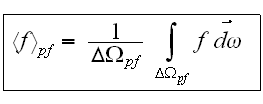 This momentum averaged equation is incorrect equation - see the analysis above
in the
http://travkin-hspt.com/urbp/turbpart/Turbpart.htm
This momentum averaged equation is incorrect equation - see the analysis above
in the
http://travkin-hspt.com/urbp/turbpart/Turbpart.htm
I consider this is the good experiment, with errors but still a good
experiment, and I would like to comment on it below
in the subsection of this website -
~~~
Finnigan, J.J., "Turbulent Flow in Canopies on Complex Topography and the Effects of Stable
Stratification," in NATO Advanced
Study Institute-980064, Institute of Hydromechanics, Kiev, pp. 20-24, 2004.
These four lectures by Profs. J.J.Finnigan and R.H.Shaw have the common basis and we would like to comment on it
as soon as it is the ground for numerous publications of few groups of meteorologists from Australia, US, England and France.
~~~
Finnigan, J.J. and Shaw, R.H., "Large-Eddy Structure and Low Dimensional Modeling of Canopy
Turbulence," in NATO Advanced
Study Institute-980064, Institute of Hydromechanics, Kiev, pp. 80-81, 2004.
Few remarks regarding this report were placed below into the "experimental" subsection -
~~~
Finnigan, J.J., "Turbulent Fine Structures and Spectra in Canopies
," in NATO Advanced
Study Institute-980064, Institute of Hydromechanics, Kiev, p. 79, 2004.
Here is the good research, but with the flawed foundation - averaged equations of turbulent transport, including the TKE and Dissipation rate equations are incorrect.
In the slide of presentation one can read - "Non-Local Transport leads to failure of K-Theory".
Of coarse - because among other reasons, these are the different spaces! We can not compare the both equations budgets using the same one scale !
Page 79 - "Both effects, which are together responsible for the enhanced rate of dissipation observed in canopies, can be equated to the rate that the turbulent flow does work against the total aerodynamic drag (pressure plus viscous) of the foliage."
The problem with this statement is that those effects for the dissipation in the canopy "porous" medium are more than those two only mentioned by author. The TKE and the dissipation rate equations averaged over the fluid phase in suggested by author forms have no integral terms in both equations, at least in the second one the integral terms specified incorrectly.
There is no sense (logic) to study the budgets in both equations and parameterize some effects in them, when the whole body of very important terms just is missing from those equations !
I had a difficult task after this NATO ASI to select the points, the arguments
those are obvious to me for more then 20 years.
Since the middle of 80-th I have been talking to students and at some conferences,
including that 1986 WMO conference - Shcherban, A.N., Primak, A.V., and
Travkin, V., "Turbulent Transfer in Urban Agglomerations on the Basis of
Experimental Statistical Models of Roughness Layer Morphological Properties",
in Proc. World Meteorological Organization Conf. on Air
Pollution Modelling and its Application, Transactions, Geneva, Vol. 2,
pp.259-266, (1986), (see this paper in the above subsection with the rules of averaging (4), and
the VAT averaged Upper scale turbulent governing equations (5) - (7)), where I firstly spoke to a wide meteorological audience
about the scaled turbulent transport in the URL, porous media, that some other advancements in
the same direction are unfound, simply incorrect.
Well, after near 20 years I saw that people in other fields using those
incorrect governing equations as the basis, referring to those publications
now accounting for more then 20 years of printing. Primarily in meteorological
journals, as "Boundary Layer Meteorology," and others.
Now, the events at this NATO ASI shown that people completely don't understand
mathematical basics, those standing behind all of these averaging procedures and
governing equations.
Researchers using those rules without knowing what kind of conditions, restrictions were applied
while they were derived ? What kind of equations are conditioned with these theorems and rules.
All of this is given in the literature on fluid mechanics (not meteorological studies),
chemical technology and thermal physics related VAT publications.
I never saw the complete paths of derivations as S.Whitaker, and W.Gray have done
regarding the laminar, half-linear governing equations?
If any of this kind of publications would be done in meteorology - the publications should inevitably contain the VAT theorems
used to derive that or those formulae, or the rule. That means these studies; these mentioned publications
in the meteorology by said groups of meteorologists would not
stand apart of the other fluid mechanics areas where the scaled VAT tasks began to find accomplishments since 80-th!
It is the good reason to speak openly about those basics
for claimed turbulent models theory by few groups of meteorologists,
associated with Profs. Shaw, Finnigan, Raupach and their collaborators in
Australia, US, England, and France.
Among a number of their publications I had selected this one.
Here we need to talk about this paper below which was
published in 2000 and pretty much serving as a summarizing paper for
publications by groups of authors using the same methodology for Turbulent
(and Laminar regime) Governing Equations (GE) for canopy (obstructed volumes)
development.

Finnigan, J., "Turbulence in Plant Canopies,"
in Annu. Rev. Fluid Mech. 2000, Vol. 32, pp. 519--571,
2000.
There are on the page 521-522 the definitions of the decomposed general
variable as

and

The question is - What are the connections between both? If

 is the instant value of a variable, then
is the instant value of a variable, then

If

 is the mean turbulent variable
is the mean turbulent variable

 then according to (2.2) (2.4) that should be
then according to (2.2) (2.4) that should be

Which is correct? The second path probably ?
Page 521 - "where the averaging volume V, which excludes solid plant parts,
consists of a horizontal slab, extensive enough in the horizontal to eliminate
plant-to-plant variations in canopy structure but thin enough to preserve the
characteristic variation of properties in the vertical."
On page. 522 we see the equality

where
"
 is the unit normal vector pointing away from
is the unit normal vector pointing away from

 into
into

 ".
And the
".
And the

 is the volume of fluid only, not all the volume of the two-phase (or more
phases inside of the real 3D volume, if any exist more than 2 phases).
is the volume of fluid only, not all the volume of the two-phase (or more
phases inside of the real 3D volume, if any exist more than 2 phases).
This equality is incorrect, instead of it should be
in the VAT notations used the consequence of the WSAM theorem
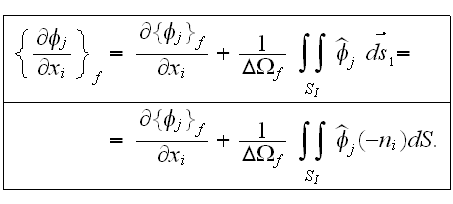
or it should be as



in notations of the paper by Finnigan. And this is the fundamental difference.
Then, the another equality (2.6) in the paper by Finnigan (2000) for the time
derivative averaging had been made as

where
"
 is the velocity of a point on the plant element surface.
is the velocity of a point on the plant element surface.
Meanwhile, the VAT's averaging "transport" theorem says that
this should be the formula

we have the discrepancy with the sign before the second r.h. term, because the
vector

 then it means that the time derivative fluid phase averaging in
notations of Finnigan & Raupach & Shaw and et
al. should be as
then it means that the time derivative fluid phase averaging in
notations of Finnigan & Raupach & Shaw and et
al. should be as

But the worse thing is that this formula is also incorrect,
because this theorem if written for the

 then in the VAT's notations will looks like
then in the VAT's notations will looks like

while using the Finnigan's notations it should be as

with the variable time dependent fluid phase volume fraction

 and of the fluid volume itself
and of the fluid volume itself


Then, on the same page 522 we see the momentum turbulent equation averaged as

where


while these last two terms are incorrect. These

 and
and

 should be different according to the WSAM theorem for the averaging of type
should be different according to the WSAM theorem for the averaging of type

 see the explanation above.
see the explanation above.
Then the next mistake is - that in the averaged momentum equation there is no
term which would reflect the integral part of the WSAM theorem when applied to
the term

 ?
?
Should be the last integral term from the WSAM theorem written for the stress term
(in paper's notations)

which is also would be incorrect if writing via the
intrinsic fluid phase averaged variables

 due to averaging mistake- see the remarks above.
due to averaging mistake- see the remarks above.
The reason why in this development should be used the phase
averages but not the intrinsic phase averages
as in this and other works by said meteorologists is that the vectorial
variables at the boundaries between the "porous" medium and the homogeneous
fluid volume medium should be conserving their values - as, for example, the
velocity, the mass flux, etc.
Then we see on page 523 the second moments equation written as the "averaged"
one in the form





with the exact notation as in (2.11) in the paper. The last two terms probably
should read the

 instead of
instead of

 etc. ?.
etc. ?.
This equation can not be called as the averaged one, few issues prevent doing
this:
1) the intrinsic phase averaging should not be applied to vectorial (tensor)
variables equation;
2) here the intrinsic phase averaging is only designated, but only two
terms had been averaged. The first one - the time derivative term,
and only with an assumption that the foliage is unmovable. The second term is
the "pressure fluctuations drag" term #VIII
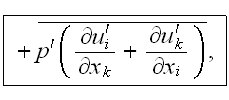
still the averaging done incorrectly. The example - the pair of terms
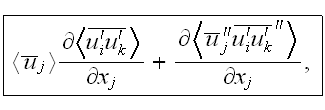
are not the averaged l.h.s. term
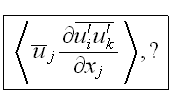
and the same can be said about other terms.
And I seems to know why these terms are not averaged. Because
some averaging mathematics techniques were not widely known in 80th. And they
are not known even today to the most of the community who do the Linear
Operators averaging.
3) The intrinsic phase averaging applied with incorrect
formulae.
Page 524 we read that - "The application of the volume average operator has
removed the dependence of the flow equations on the stochastic distribution of
the foliage." ?
Of coarse, not. This action just transformed the lower scale
problem into the other one - the Upper space problem, but the morphology plays
the vital role in any space into which it is taken as a part of the
problem.
Then we see on the page 561 the kinetic energy equation
written as the "averaged" in the form



which also is not the averaged equation. All remarks above regarding the
second moments equation applicable to this one also.
The important thing is - that even in these forms the
equations (2.11) (7.1) can not be solved, because they used to be written in
the forms which include the new unknown variables. That means, they were
developed without a meaning to be solved? The calculation of
these equations budgets has no sence - because the terms are not complete, and
the problems still being considered as the Lower scale problem.
Also, there is no one reference in the list of references to
the publications on the same topic from other fields, which is like raising
the question - author doesn't know or doesn't want to show to reader that
there is the huge literature exists on the same or close AVERAGING
topics?
More of that, there are no references to the publications of
the real pioneers in the scaling description of physical processes - Volume
Averaging Theory and techniques, I mean first of all - by Whitaker, Slattery,
Gray, with their co-authors regarding the first time developments in this
science. Then, when we talk about the nonlinear and turbulent transport two scale
advancements - then, I am sorry, my work is of the first of this kind. I am
sorry, that I saying like this, but I just have mentioned few dramatic errors
in the mentioned meteorologists studies.
I actually spoke openly and published about this situation with averaged
equations in the USSR in 80th, and since 1990 in the US. If the concerned people
didn't pay attention, or didn't understand this mathematics, or if meteorologists do not read other then
"Boundary-Layer Meteorology" magazines and publications! Then What?
All of that had brought the situation to the present state of
affairs with this drastic "deflection" of studies of these groups of
meteorologists from others developments!! This is the grim situation - and I
would like suggesting the cooperation in search for the ways out?
~~~
Shaw, R.H., "Observation and Simulation of Flow in Vegetation Canopies
," in NATO Advanced
Study Institute-980064, Institute of Hydromechanics, Kiev, pp. 41-43, 2004.
On page 41 author writes: "Mathematical models of flow through canopies range from ensemble-average models that employ mixing length hypotheses (Wilson and Shaw, 1977) to large-eddy simulation (Shaw and Schumann, 1992). Such models include mathematical descriptions of the drag of foliage elements (Raupach and Shaw, 1982), and of exchangers of heat and mass according to local conditions and appropriate coefficients."
It's need to be said that the "ensemble-average models" if correctly performed are the Upper scale models - the very different from the one scale LES models. So - those two are not the consecutive rungs in the ladder of improving models. They are from different spaces.
"The problems associated with the overall complexity of plant canopy morphology, the large dynamic range of physical scales of the canopy and its components, the flexibility of canopy elements, and mutual shading of foliage parts are generally dealt with in only the most rudimentary fashion."
The author speaks only about situation within the meteorology field, he does not refer to other areas, sciences because he apparently does not have information what's going on in other fluid mechanics, thermal physics, chemical technology, etc. areas, of coarse we are referring to the VAT.
It seems that this author disregarding and stop believing in his own efforts starting in 80th related to averaging ABL governing equations in canopies.
~~~
Shavit, U. and Rosenzweig, R., " Theoretical, Numerical, and Experimental
Study of the Macroscopic Velocity Profile Near Permeable Interfaces,"
in NATO Advanced Study Institute-980064, Institute of
Hydromechanics, Kiev, pp. 172-173, 2004.
On page 173 we can read - "The theoretical part of the work includes a description
of the averaging procedure for the Navier-Stokes equations over a
representative elementary volume (REV). The result of the mathematical
formulations is the MRE (Modified Brinkman Equation). The MBE is composed of
three differential equations that provide the average velocity profile above,
within and below the interface region. The first equation, which describes the
flow at the free fluid, is similar to the Stokes equation. The third equation,
far below the interface, resembles the Brinkman equation. The second equation,
which describes the velocity around the interface region, is more complex and
involves terms accounted for the porosity variation across the interface."
This text speaks out obviously about incorrect approach to the averaging process, and to closure of the equations in different areas.
This is the kind of equation which can not be derived unless the goal was to make it up.
Authors probably had not read the papers by Whitaker (and few other people) written on this subject.

Copyright © 2001...Sunday, 29-Jun-2025 16:33:16 GMT V.S.Travkin, Hierarchical Scaled Physics and Technologies™

 here the averaging
here the averaging

 should mean the averaging over the fluid volume only, which in VAT is
should mean the averaging over the fluid volume only, which in VAT is

 and
and

 is the fluctuation in the fluid phase (not known how it is exactly relates to
other variables).
is the fluctuation in the fluid phase (not known how it is exactly relates to
other variables).





















































